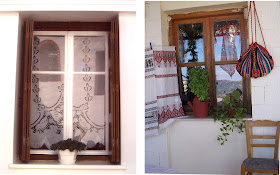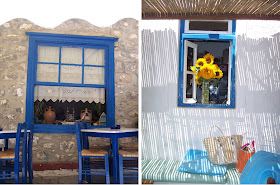As I’ve mentioned before, when I’m traveling in Greece, I
find myself often photographing windows. (In Paris it’s doors and in Nicaragua,
it’s chairs!)
Greek windows, with their pristine white lace or cut-work
curtains and the inevitable pot of basil in the window, are so carefully
composed and so indicative of the creativity of the homemaker within, that I think
you can call them found art.
The pot of basil, by the way, is not just for cooking. It’s considered a holy plant, and
brings good luck, so every home must have one.
At the recent Grecian Festival in the Cathedral of Saint
Spyridon, our church in Worcester, MA,
I sold out of the packets of note cards of my Greek windows. Guess I’d better print some more.
Here are eleven of the designs and a little about where I
found them.
The window on the left, on the green island of Skopelos in the northeast, demonstrates the beautiful cutwork of the handmade curtains. The reflection shows the arched window of a church (?) next door.
The window on the right, of a shop in the mountains of Crete, displays the colorful local embroidery and the classic caned Greek chair found everywhere throughout the country.
Both these windows are in the charming Hotel Kastro, in the walled city in Yannina, Greece, which looks exactly as it did when the Turks ruled the country. Now the mosques have been turned into museums, but the city still has the exotic beauty that seduced Lord Byron when he came to visit Ali Pasha and marvel at his riches. The window on the left shows the Greek tendency to train climbing vines everywhere. In the photo on the right, I was remembering something my friend, award-winning photographer Mari Seder, once told me--sometimes the shadows are the most important part of the photograph.
On the left, a window in a popular taverna on the island of Hydra, echoes the blue and white of the Greek flag. The miniature sailing boat in the window speaks of the seafaring history of the island. The window on the right belongs to a humble restaurant on Mykonos, tucked far, far away from the areas thronged with tourists. The food is magnificent and so is the view. If I could remember the name of the restaurant I wouldn't tell. Its patrons want to keep it unspoiled. (Here's a hint. The beach far below is called Agios Sostis.)
The window on the left is in a very rustic eco-resort--Milia-- high in the mountains of Crete. The views far down the mountain are to die for. On the right, in the unique town of Pirgi, on the island of Chios, the curtain in the window echoes the geometric designs scratched into the plaster of the exterior walls on all the buildings.
On the left, outside a taverna on Crete, is what I call the mermaid window, although it may have started life as a door before it was boarded up and turned into illustrations for the story of the Gorgona--the giant mermaid who was the sister of Alexander the Great before he cursed her. (If you want to know the whole story of the mermaid, read it in my book "The Secret Life of Greek Cats.")
The window on the right is in an ancient church in the beautiful town of Pirgi on the island of Chios. Originally I posted this photo in a blog post called "The Scraped Walls of Pirgi, Chios". I said the angel-like figure over the window was a representation of the Holy Spirit, but I was wrong. A sharp-eyed and much better-informed reader named Matthew Kalamidas wrote: "Lastly, the angel in the wall painting is actually a six-winged seraphim. In Greek, an exapterygo. Besides the six wings, the words beside it are 'Holy, Holy, Holy Lord', which is an abbreviated form of the never-ending prayer."
That's one of the great things about writing blog posts -- you learn so much.







Julie said: These are beautiful. Thanks for sharing them.
ReplyDeleteBeautiful collection, we have alot more styles in almost every area of Greece!
ReplyDelete